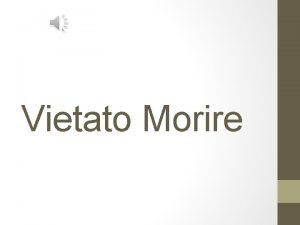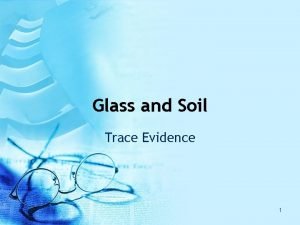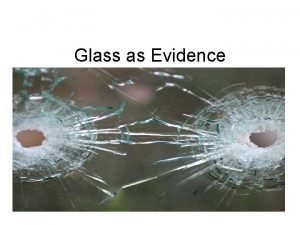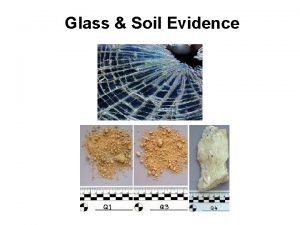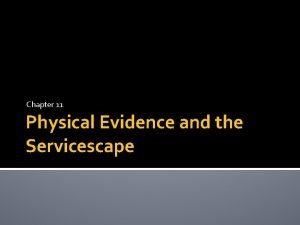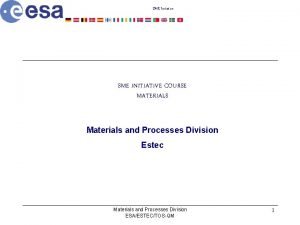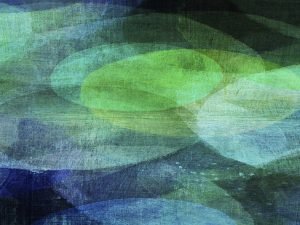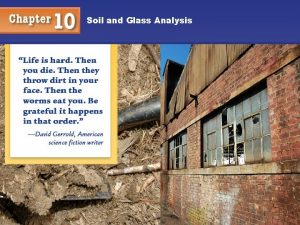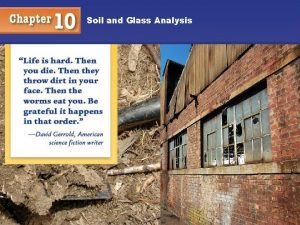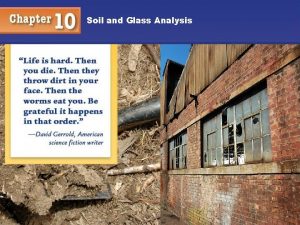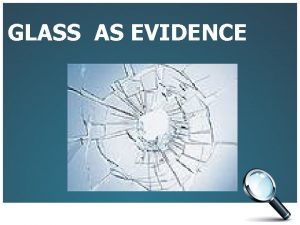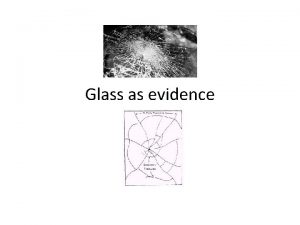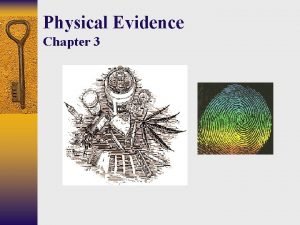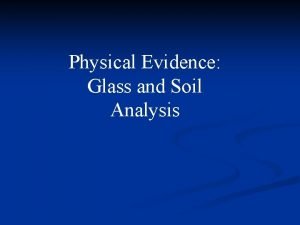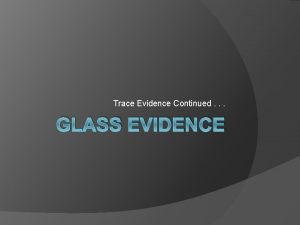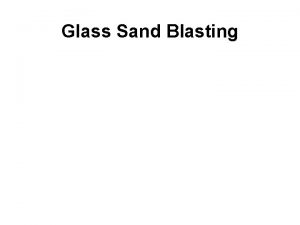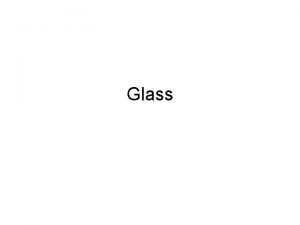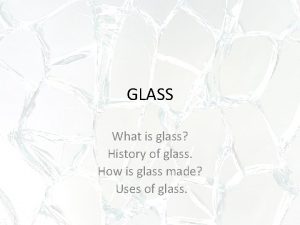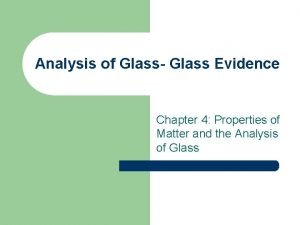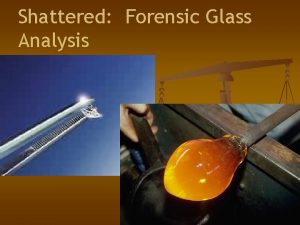Physical Evidence Glass and Soil Analysis CHE 113



































- Slides: 35

Physical Evidence: Glass and Soil Analysis CHE 113 Forensic Science James T. Spencer Copyright 2004 -2006 1

Glass Analysis • Glass is found in many types of cases - burglaries and hit-and-runs. • Glass fragments easily embed in shoes and clothing of people involved in the breakage of glass. • Glass can give class characteristics • Can give individual characteristics where a piece of glass that was broken is reconstructed when fractured pieces are fit together. CHE 113 2

Glass Analysis • Mostly Class evidence from: • Broken Windshield Fracture Match • Stress Marks in Broken Glass • Molotov Cocktail from Fire • Broken Bottles (from inside or outside) • Burglery • Vandalism • Comparison of Glass Fragments CHE 113 3

What Is Glass? • Glass is made of silicon oxide and metal oxides • Sand metal oxides are melted and then cooled. • Yields an amorphous liquid (liquid!). No crystal structure. • Glass flows even at room temperature (but very slowly). • Hard and Brittle http: //www. glassonweb. com/glassmanual/index. php CHE 113 4

How Is Glass Made? • • • BLOWN OR SPIN GLASS FLOAT GLASS PROCESS ROLLED GLASS PROECSS http: //www. glassonweb. com/glassmanual/index. php CHE 113 5

How Is Glass Made? • FLOAT GLASS PROCESS - ( 1959, ca. 90% of flat glass) • The raw materials (soda lime, silica sand, calcium, oxide, soda and magnesium) are weighted, mixed and melted at 1500° C. • molten glass flows from the furnace onto a bath of molten tin in a continuous ribbon (glass and the tin do not mix - the contact surface is perfectly flat. • When leaving the bath of molten tin the glass has cooled down sufficiently to pass to an annealing chamber. http: //www. glassonweb. com/glassmanual/index. php CHE 113 6

How Is Glass Made? FLOAT GLASS PROCESS http: //www. glassonweb. com/glassmanual/index. php CHE 113 7

How Is Glass Made? • ROLLED GLASS PROCESS - Glass is made through a rolling process, whereby the semimolten glass is squeezed between metal rollers to produce a ribbon with pre-defined thicknesses and patterned surfaces. This process is used for patterned figure and cast glass production. http: //www. glassonweb. com/glassmanual/index. php CHE 113 8

Glass Analysis • Window and bottle glass are made of sodalime, sand, and the following metal oxides: sodium, calcium, magnesium, and aluminum. • Auto headlights and heat-resistant glass also have boron oxide. • Tempered glass is stressed glass that is rapidly heated and cooled. • Laminated glass is used as windshields and is made by sandwiching a piece of plastic between two pieces of window glass (all US windshelds). CHE 113 9

Glass Analysis • Laminated Glass vs. Tempered Glass CHE 113 10

Glass Analysis • Most glass analysis compares the refractive indices, elemental compositions, and densities of two or more samples (class). • Sometimes a fractured glass object can be reconstructed. Due to the vast number of ways such a lens could break, a piece of glass fitting into such a reconstruction would constitute an actual identification (v. high probability). CHE 113 11

Glass Analysis • Two kinds of fractures, radial fractures (those radiating from the center) and concentric fractures. CHE 113 12

Glass Analysis • The direction of force in breaking a window pane can be determined by the direction of the rib marks (stress marks left on broken edges of glass that are perpendicular to one side and that curve tangentially, run almost parallel, to the other side). CHE 113 13

Glass Analysis • On radial fractures (those radiating from the center) the direction of the force is on the same side as the tangential (almost parallel) parts of the rib marks. • The edge of the glass where the rib lines are perpendicular is not the side of the glass that the force came from. This is the little R rule—radial cracks make right angles to the rear. CHE 113 14

Glass Analysis • On concentric fractures, the perpendicular part of the rib mark is the side from which the breaking force came. The rib fractures DO make a right angle to the side the force came from. • If you’re standing inside and break a pane of glass, most of the glass will land outside—but some will fly backwards towards you, landing inside the house and depositing tiny shards CHE 113 15 on your clothing.

Fracture Analysis Radial Crack Concentric Crack Radial cracks make Right angles to the Rear. CHE 113 16

Windshield Glass Area on a windshield where the wiper blades cross Area on a windshield where only one wiper blade sweeps Scratches on a side window from grit caught in the rubber CHE 113 17

Glass Analysis • If a window is broken by a bullet, it is possible to determine the bullet's direction by noting the side of the coneshaped hole left by the bullet. The small opening is on the entrance side and the large opening is on the exit side. • A determination of the sequence of bullet holes can be made by noting the radial fractures. Radial fractures caused by the passage of a bullet will stop at any preexisting fracture. CHE 113 18

Glass Analysis • A bullet makes a clean-cut hole in the side of entrance and causes a saucer-shaped or coning depression on the exit side, with a greater diameter than the entrance hole. • Glass fractures caused by a blunt object will show a pattern of fractures like, but not as regular as, the pattern from a bullet. • Fractures due to heat are wave-shaped. They do not show a regular pattern of radial and concentric lines like fractures caused by impact. CHE 113 19

Glass Analysis • Physical Measurements and Chemical Composition of Glass: • Density • Refractive Index (most glass is the same - but can tell if two samples are different) • Polarizing Microscopy (determine tempered glass) • IC-MS (inductively coupled mass spectrometer) CHE 113 20

Glass Analysis • Physical Measurements and Chemical Composition of Glass: • Density • Floatation Method • Gradient Tubes • Volumetric Measurements (mass measurement and volume by displacement) CHE 113 21

Archimedes (287 -212 BC) Suspecting that a goldsmith might have replaced some of the gold by silver in making a crown, Hiero II, the king of Syracuse, asked Archimedes to determine whether the wreath was pure gold. The wreath could not be harmed since it was a holy object. The solution which occurred when he stepped into his bath and caused it to overflow was to put a weight of gold equal to the crown, and known to be pure, into a bowl which was filled with water to the brim. Then the gold would be removed and the king's crown put in, in its place. An alloy of lighter silver would increase the bulk of the crown and cause the bowl to overflow. Pure Gold? Equal Weight of Gold Crown Displaced More CHEWater 113 22

Glass Analysis • Refractive Index of Glass • Uses Becke Line - a bright halo of light that appears around the perimeter of a particle when the indices of refraction of the particle and surrounding medium are different. Glass has higher refractive index Becke line seen inside Rays converge RI(glass) > RI(solvent) Glass has lower refractive index Becke line seen outside Rays diverge RI(glass) < RI(solvent) CHE 113 23

Glass Analysis Refractive Index of Class 1. Hot stage microscope used 2. Glass is immersed in RI liquid which is higher RI than glass. Temperature is raised until Becke line disappears. Rate of change of RI in liquid is known (-3 x 10 -4/degree) so the RI of the unknown can be determined 3. The point where the Becke line disappears: RI of the sample = the RI of the liquid CHE 113 24

Soil Analysis What Is Soil? • Mixture of organic and inorganic material • May range from 100% inorganic (sand) to nearly 100% organic (peat) • Inorganic part is minerals • Organic part is decayed plant and animal material and is sometimes called humas CHE 113 25

Soil Analysis "For example, observation shows me that you have been to the Wigmore Street Post-Office this morning, but deduction lets me know that when there you dispatched a telegram. " "Right!" said I. "Right on both points! But I confess that I don't see how you arrived at it. It was a sudden impulse upon my part, and I have mentioned it to no one. " "It is simplicity itself, " he remarked, chuckling at my surprise --"so absurdly simple that an explanation is superfluous; and yet it may serve to define the limits of observation and of deduction. Observation tells me that you have a little reddish mould adhering to your instep. Just opposite the Wigmore Street Office they have taken up the pavement and thrown up some earth, which lies in such a way that it is difficult to avoid treading in it in entering. The earth is of this peculiar reddish tint which is found, as far as I know, nowhere else in the neighbourhood. So much is observation. The rest is deduction. " CHE 113 26 (From The Sign of Four by Arthur Conan Doyle)

Soil Analysis • Forensic Geology - scientific application of earth sciences to legal matters. • identifying, analyzing, and comparing earth materials, such as soil, rocks, minerals, and fossils found on or in a receptor (e. g. , a suspect, a vehicle or other medium of transfer, such as water) to possible source areas (e. g. , a crime scene, an alibi location, and/or a point of disposal/release). • Goal - • establish the probability that the material was derived from a particular location • determine the time an incident occurred, the cause of an incident and/or responsibility for an incident. CHE 113 27

Soil Analysis • • • Bulk analysis Density gradient Particle size distribution (sieving) Inorganic components Color (dissolve in water) Petrography - mineral analysis Organic components Liquid chromatography Oxygen availability Bacterial DNA? CHE 113 28

Soil Analysis • Hit and Run: - Under-fender dirt/soil deposited at impact with the victim. matching the grease on the victim with the grease under the car. • Rape: - Soil on clothing of a suspected rapist placed suspect at the crime scene. • Murder: - Soil found on murder victims used to determine the location of homicides, especially when the murder occurs in one location and the body is then moved. Using water-current measurements, bodies/objects thrown into water can be located and where a discovered body/object originally entered the water determined. • Assault: - Identifying the type of rocks used as weapons led to the source of the rocks and helped locate suspects. CHE 113 29

Soil Analysis: Cases • Soil - rape suspect had soil samples on each knee of his pants that matched the soil types from the right and left knee impressions at the rape scene. • Groundwater contamination - determined the time a chemical release contaminated water supplies. • Contamination in groundwater at a company originated at another property and a different company was responsible for cleanup. • Geologic analyses of roadways in other cases have shown that unpaved roads were improperly constructed and/or improperly maintained. CHE 113 30

Soil Analysis (1908) A man with a bad reputation was under investigation for the murder of Margaeth Filbert in Bavaria, Germany. Investigating mud on the suspect's shoes helped solve the case. The suspect's wife testified that she had cleaned her husband's shoes the day before the crime. Those shoes had three layers of soil adhering to the leather in front of the heel with the innermost layer as the oldest. It contained goose droppings et al, matching samples from the walk outside the suspect's home. The second layer contained red sandstone fragments that compared with samples taken where Filbert's body had been found. The last layer contained brick, coal dust, cement and other materials that matched samples taken outside a castle where the suspect's gun and clothing had been found. The suspect claimed he'd been walking in his fields the day of the crime. The lie didn't stick. Those fields were underlain by porphyry with milky quartz, and the soil had been wet that day. But they found no such material on the suspect's shoes. CHE 113 31

Soil Analysis • Soil is frequently found on clothing, shoes, or tools and in the wheel wells of vehicles. • Most soil analysis consists of comparing two or more samples by their mineral content, color, and density. The presence of pesticides and herbicides have also been used in soil comparison. CHE 113 32

Soil Analysis THE CAMARENA CASE In 1985, an agent with the U. S. Drug Enforcement Agency, Enrique Camarena Salazar, was kidnapped near Guadalajara. The U. S. government demanded that the Mexican government and Mexican Federal Judicial Police (MFJP) find Camarena. Eventually the MFJP announced finding Camarena's body on the El Mareno ranch in Michoacan State, the site of a shootout between Mexican police and alleged drug dealers. But an investigation by the FBI showed that Camarena's body had been buried elsewhere before arriving at the ranch. The clue was a specific tuffaceous rhyolite ash found in material adhering to Camarena's exhumed body. The ash helped investigators find Camarena's original burial site - a grave in a state park called Bosques de la Primavera, far from the ranch. The body had been removed from that site to the ranch, and the investigation helped reveal a cover-up by the MFJP. CHE 113 33

Soil Analysis • Microscopic fossils called diatoms collectively deposited to form a sedimentary rock called diatomaceous earth. Some manufacturers use diatomaceous earth for insulating safes. Burglary crimes have been solved by examining white specks from suspects' hair and clothing to determine that the specks were actually diatoms that came from broken safes at crime scenes, and not dandruff as the suspects had claimed. CHE 113 34

CHE 113 35
 Living soil vs dead soil
Living soil vs dead soil What are the four spheres of the earth
What are the four spheres of the earth Glass escalator concept
Glass escalator concept If acid is splashed on your skin wash at once with
If acid is splashed on your skin wash at once with Does hot glass look like cold glass
Does hot glass look like cold glass Explain how class evidence may be useful.
Explain how class evidence may be useful. Frasi con le proposizioni oggettive
Frasi con le proposizioni oggettive Ricordo quegli occhi pieni di vita
Ricordo quegli occhi pieni di vita Che che kooley
Che che kooley Facesti come quei che va di notte che porta il lume
Facesti come quei che va di notte che porta il lume Soil trace evidence
Soil trace evidence Hard soil evidence
Hard soil evidence Hard soil evidence
Hard soil evidence Is glass class evidence
Is glass class evidence Glass evidence in forensic science
Glass evidence in forensic science Phy 113 past questions and answers
Phy 113 past questions and answers Philosophy and human existence gst 113
Philosophy and human existence gst 113 Secondary sources
Secondary sources Primary evidence vs secondary evidence
Primary evidence vs secondary evidence Primary evidence vs secondary evidence
Primary evidence vs secondary evidence Primary evidence vs secondary evidence
Primary evidence vs secondary evidence Jobs vancouver
Jobs vancouver Are fibers class evidence ?
Are fibers class evidence ? Class vs individual evidence
Class vs individual evidence A pair of latex gloves was found at a crime scene
A pair of latex gloves was found at a crime scene Ecologic fallacy
Ecologic fallacy Servicescape examples
Servicescape examples Elements of physical evidence
Elements of physical evidence Psalm 113:1-4
Psalm 113:1-4 Solithane 113
Solithane 113 Psalm 113:1-4
Psalm 113:1-4 113-com-1022 powerpoint
113-com-1022 powerpoint Perform voice communications 113-com-1022
Perform voice communications 113-com-1022 Nota kawad kaki kesatria negara uitm
Nota kawad kaki kesatria negara uitm Ind as 113 does not apply to
Ind as 113 does not apply to What does montag hear in the seashell
What does montag hear in the seashell







